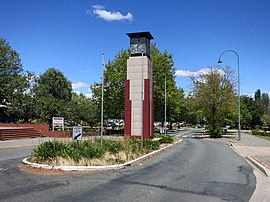| Nicholls Canberra, Australian Capital Territory | |||||||||||||||
|---|---|---|---|---|---|---|---|---|---|---|---|---|---|---|---|
 O'Hanlon Place, Nicholls | |||||||||||||||
| Coordinates | 35°11′10″S 149°05′31″E / 35.186°S 149.092°E | ||||||||||||||
| Population | 6,680 (SAL 2021)[1] | ||||||||||||||
| Established | 1994 | ||||||||||||||
| Postcode(s) | 2913 | ||||||||||||||
| Elevation | 624 m (2,047 ft) | ||||||||||||||
| Area | 6.7 km2 (2.6 sq mi) | ||||||||||||||
| Location |
| ||||||||||||||
| District | Gungahlin | ||||||||||||||
| Territory electorate(s) | Yerrabi | ||||||||||||||
| Federal division(s) | Fenner | ||||||||||||||
| |||||||||||||||
Nicholls is a suburb in the Canberra, Australia district of Gungahlin. It was named after Sir Douglas Nicholls (1906–1988) who was born at Cummeragunja Aboriginal mission, New South Wales. Nicholls was a footballer, pastor, activist, and Governor of South Australia, 1976–1977. In line with the philosophy of naming Canberra's streets, those of Nicholls are named after sportspeople.[2] The suburb incorporates a large shallow body of water, designated Gungahlin Pond, with The Lakes golf course and the greatest number of residential streets on one side and a small cluster of residential streets, the "pondside promenade",[2] named after birds, on the other. There is no direct connecting road between the two.
Nicholls adjoins the suburbs of Kinlyside, Casey, Ngunnawal, Crace and Palmerston. The suburb is located approximately 2 km from the Gungahlin Town Centre and about 13 km from the centre of Canberra.
- ^ Australian Bureau of Statistics (28 June 2022). "Nicholls (suburb and locality)". Australian Census 2021 QuickStats. Retrieved 28 June 2022.
- ^ a b "Place Name Search". ACT Environment and Sustainable Development. Retrieved 30 January 2023.
